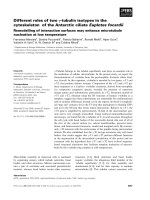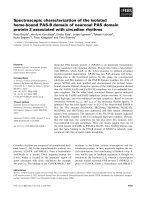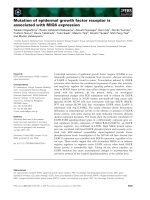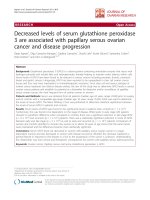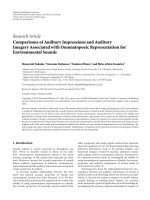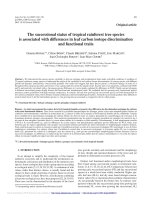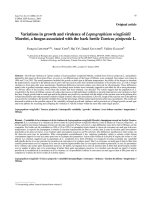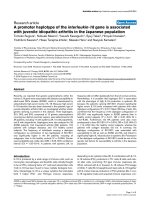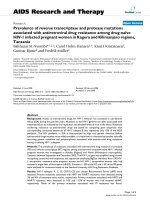Overwintering Survival of Strawberry (Fragaria x ananassa): Proteins Associated with Low Temperature Stress Tolerance during Cold Acclimation in Cultivars
Bạn đang xem bản rút gọn của tài liệu. Xem và tải ngay bản đầy đủ của tài liệu tại đây (10.17 MB, 140 trang )
Graduate School ETD Form 9
(Revised 12/07)
PURDUE UNIVERSITY
GRADUATE SCHOOL
Thesis/Dissertation Acceptance
This is to certify that the thesis/dissertation prepared
By
Entitled
For the degree of
Is approved by the final examining committee:
Chair
To the best of my knowledge and as understood by the student in the Research Integrity and
Copyright Disclaimer (Graduate School Form 20), this thesis/dissertation adheres to the provisions of
Purdue University’s “Policy on Integrity in Research” and the use of copyrighted material.
Approved by Major Professor(s): ____________________________________
____________________________________
Approved by:
Head of the Graduate Program Date
Gage Koehler
Overwintering Survival of Strawberry (Fragaria x ananassa): Proteins Associated with Low
Temperature Stress Tolerance during Cold Acclimation in Cultivars
Doctor of Philosophy
Dr. Christopher Staiger
Dr. Paul M. Hasegawa
Dr. Stephen Randall
Dr. Jonn Watson
Dr. Bonnie Blazer-Yost
Dr. Stephen Randall
Dr. Simon Atkinson
11/16/2011
Graduate School Form 20
(Revised 9/10)
PURDUE UNIVERSITY
GRADUATE SCHOOL
Research Integrity and Copyright Disclaimer
Title of Thesis/Dissertation:
For the degree of
Choose your degree
I certify that in the preparation of this thesis, I have observed the provisions of Purdue University
Executive Memorandum No. C-22, September 6, 1991, Policy on Integrity in Research.*
Further, I certify that this work is free of plagiarism and all materials appearing in this
thesis/dissertation have been properly quoted and attributed.
I certify that all copyrighted material incorporated into this thesis/dissertation is in compliance with the
United States’ copyright law and that I have received written permission from the copyright owners for
my use of their work, which is beyond the scope of the law. I agree to indemnify and save harmless
Purdue University from any and all claims that may be asserted or that may arise from any copyright
violation.
______________________________________
Printed Name and Signature of Candidate
______________________________________
Date (month/day/year)
*Located at />Overwintering Survival of Strawberry (Fragaria x ananassa): Proteins Associated with Low
Temperature Stress Tolerance during Cold Acclimation in Cultivars
Doctor of Philosophy
Gage Koehler
11/16/2011
OVERWINTERING SURVIVAL OF STRAWBERRY (FRAGARIA X ANANASSA):
PROTEINS ASSOCIATED WITH LOW TEMPERATURE STRESS TOLERANCE
DURING COLD ACCLIMATION IN CULTIVARS
A Dissertation
Submitted to the Faculty
of
Purdue University
by
Gage Koehler
In Partial Fulfillment of the
Requirements for the Degree
of
Doctor of Philosophy
December 2011
Purdue University
Indianapolis, Indiana
ii
ACKNOWLEDGMENTS
Several people have made this thesis possible. I am especially thankful to Dr. Stephen
Randall for his help and support in guiding me through to its successful completion. My
deep gratitude is expressed to Dr. Muath Alsheikh for his support and encouragement to
participate in this project.
I also warmly acknowledge Dr. John Watson for his inspiring guidance and insightful input
throughout the process of this research, as well as Dr. Staiger, Dr. Hasegawa, and Dr.
Bonnie Blazer-Yost for their time and valuable feedback during the investigation of this
project.
Achieving the goals of this project was facilitated by the use of resources and equipment,
generously provided by Dr. Frank Witzmann. This project also benefitted from the expert
advice and experience of many colleagues to whom I am grateful, including the valuable
contributions made by Xianyin Lai to the LC-MS/MS peptide identifications and the
statistical analysis performed by Dr. John Goodpaster.
I am also deeply grateful for Howard Creveling, for generously making the Elizabeth Steele
Creveling Memorial Scholarship available to me and other students who have received this
honor.
A very special recognition is given to Yuji Yamasaki for his support, exemplary
professionalism, and excellent sense of humor.
iii
TABLE OF CONTENTS
Page
LIST OF TABLES v
LIST OF FIGURES vi
LIST OF ABBREVIATIONS viii
ABSTRACT xiii
CHAPTER 1. INTRODUCTION 1
1.1. Processes Associated with Reliable Overwintering Survival 1
1.1.1. Membrane Modifications and Lipid Biosynthesis 2
1.1.2. Cytoskeleton in Response to Cold Exposure 2
1.1.3. Reactive Oxygen Species 3
1.1.3.1. Antioxidant 5
1.1.3.2. Detoxification 6
1.1.4. Chaperones 7
1.1.5. Pathogenesis-Related Proteins 8
1.1.6. Dehydrins 9
1.2. Significance Aspects from this Study 10
1.3. Explanation of Interrelatedness of Chapters 11
CHAPTER 2. PROTEOME ANALYSIS OF CROWNS OF
FRAGARIA ANANASSA CULTIVARS WITH DIFFERENT FREEZING
TOLERANCE 14
2.1. Introduction 14
2.2. Methods 16
2.2.1. Plant Material and Experimental Design for Freezing Experiment 16
2.2.2. Plant Material for Protein Analysis 18
2.2.3. Sample Preparation for 2DE 18
2.2.4. 2DE (Two-Dimensional Gel Electrophoresis) 19
2.2.5. 2DE Gel Imaging and Data Analysis 20
2.2.6. 2DE Protein Identification by LC-MS/MS 21
2.2.6.1. Protein Confidence Values Listed as Protein Probability 21
2.2.6.2. Protein Confidence Values Listed as q-values 22
2.2.7. Shotgun Proteomics 22
2.2.8. Western Blots 23
2.3. 2DE Results 24
2.3.1. 2DE Maps of F. × ananassa Crown Tissue 25
2.3.2. Agglomerative Hierarchical Clustering (AHC) of 2DE Data 30
2.3.3. Principal Component Analysis (PCA) of ‘Jonsok’ and ‘Frida’ 30
2.3.4. 2DE Protein Spot Comparison for ‘Jonsok’ and ‘Frida’ 33
iv
Page
2.3.5. Functional Categories of Identified Proteins from 2DE 40
2.4. Shotgun Results 43
2.5. Discussion 47
2.5.1. Comparison of 2DE Protein Expression in ‘Jonsok’ and ‘Frida’ 47
2.5.1.1. Proteins Involved in the Phenylpropanoid Biosynthetic Pathway 47
2.5.1.2. Proteins Associated with Pathogen Resistance 50
2.5.1.3. Antioxidative and Detoxification Proteins 51
2.5.1.4. Anoxia/Hypoxia Related Proteins 55
2.5.1.5. Other Proteins Associated with Freezing Stress Tolerance 56
2.5.2. Comparison of 2DE and Shotgun-based Approaches 63
2.5.3. Shotgun Proteomics Approach Corroborates 2DE Findings 64
2.5.4. 1-DE Western Blot Analysis Validates 2DE Observations 66
2.6. Conclusion 68
CHAPTER 3. COLD-REGULATED PROTEINS IN LEAVES OF
FRAGARIA ANANASSA ‘KORONA’ 70
3.1. Introduction 70
3.2. Methods 71
3.2.1. Plant Growth and Cold Treatment 71
3.2.2. 2DE and Gel Imaging 71
3.2.3. 2DE Protein Identification by LC-MS/MS 72
3.2.4. Western Blotting 72
3.3. Results 72
3.3.1. 2DE Analysis of Total Proteins in F. × ananassa Leaves 72
3.3.2. Evaluation of Dehydrin levels in ‘Korona’ Leaves 74
3.4. Discussion 74
CHAPTER 4. SUMMARY 83
4.1. Summary of Results 84
CHAPTER 5. FUTURE WORK 86
BIBLIOGRAPHY 87
APPENDICES
Appendix A. Protein Extraction from Strawberry Crown Tissue 98
Appendix B. Permissions for Publications 101
VITA 102
PUBLICATIONS 104
v
LIST OF TABLES
Table Page
Table 2.1 Strawberry (F. × ananassa) cultivars used in the freezing experiments 17
Table 2.2 Summary of freezing conditions for experiment 1, 2, and 3 17
Table 2.3 Freeze injury in strawberry plants determined by scoring 1-5. 17
Table 2.4 Freezing survival demonstrates the relative cold/freezing tolerance of
F. × ananassa cultivars. 24
Table 2.5 Exponential extrapolated killing curves indicated 50% survival of ‘Jonsok’ at
approximately -8.3 ºC and for ‘Frida’ at approximately -5.5 ºC. 25
Table 2.6 The 110 proteins from 2DE experiments of Fragaria × ananassa
crown identified by LC-MS/MS 27
Table 2.7 Identity of the proteins characterized by 2DE which distinguish the
two cultivars, ‘Jonsok’ and ‘Frida’ 37
Table 2.8 The differentially expressed proteins identified in ‘Jonsok’ (A)
and ‘Frida’ (B) that are included in the 'response to stress’ and ‘response
to abiotic or biotic stimulus’ categories in GO Biological Processes 42
Table 2.9 Proteins which distinguish the two cultivars, ‘Jonsok’ and ‘Frida’.
This list contains the GenBank accession codes (gi), and number of peptides
(and distinct peptides sequences) identified by LC-MS/MS from the “shotgun”
approach for 115 proteins that were at different levels in ‘Jonsok’ and ‘Frida’. 44
Table 2.10 Proteins identified in both LFQP shotgun and 2DE analysis. 66
Table 3.1 Proteins identified from 2DE analysis of F. × ananassa ‘Korona’ leaf by
LC-MS/MS. Thirty-five identified protein spots are ranked by spot ID
(2DE identifier) with accession code (gi), confidence scores and number
of distinct peptides and number of peptides corresponding to LC-MS/MS. 78
vi
LIST OF FIGURES
Figure Page
Figure 1.1 Overview of experiments for F. ananassa 13
Figure 2.1 An example of visible freezing damage in crown tissue 18
Figure 2.2 2DE gel of F. × ananassa crown proteins (‘Jonsok’ at 2 days 2 ºC treated).
The 110 proteins identified by LC-MS/MS (Table 2.6) are indicated with
spot numbers 26
Figure 2.3 Agglomerative hierarchical clustering (AHC) indicates that cultivars and
treatments group into distinct clades and subclade 32
Figure 2.4 Principal component analysis (PCA) indicates ‘Frida’ and ‘Jonsok’ protein
composition are distinctive and that they respond differently to cold stress 33
Figure 2.5 Differentially expressed proteins in ‘Frida’ and ‘Jonsok’ 35
Figure 2.6 Protein differences and significances in ‘Jonsok’ and ‘Frida’ at 42 day cold
treatment. Volcano plot was obtained by plotting the log2 ratio of mean values
(‘Jonsok’/‘Frida’) for the 900 matched 2DE spots at 42 day cold treatment
against the negative log10-transformed P-value from the Student’s t-test. 36
Figure 2.7 2DE maps illustrating the proteins that are differentially accumulated in
‘Jonsok’ and ‘Frida’. 2DE gels of F. × ananassa ‘Jonsok’ (top) and ‘Frida’ (bottom)
from 2 day cold treatment (2 ºC) from crown tissue. 39
Figure 2.8 Gene Ontology (GO) annotation for identified proteins from 2DE analysis.
GO categories are shown for Biological Process (A), Cellular Component (B), and
Molecular Function (C) for the Arabidopsis thaliana genome, and for all
110 identified 2DE spots (F. × ananassa crown) 41
Figure 2.9 Proteins identified in the flavonoid pathway were most abundant in ‘Frida. 49
Figure 2.10 Levels of proteins associated with pathogen resistance distinguish
‘Jonsok’ (black bars) from ‘Frida’ (gray bars). Bar graphs show the average
normalized values (from PDQuest, n=3) with standard deviations for each
time point (0, 2, 42 days of cold treatment at 2 ºC) for ‘Frida’ and ‘Jonsok’. 50
Figure 2.11 Levels of proteins associated with antioxidation and detoxification
distinguish ‘Jonsok’ from ‘Frida’ 54
Figure 2.12 The 110 identified protein spots from 2DE analysis are illustrated for
the four cultivars (in order from most to least freezing tolerant; ‘Jonsok’, ‘Senga
Sengana’, ‘Elsanta’, and ‘Frida’ for the three experimental time points
(0, 2, and 42 day cold treatment) 62
Figure 2.13 Confirmation of two potential biomarkers using 1-DE western blot
analysis. ‘Jonsok’ and ‘Frida’ crown proteins (25 μg) from 0, 2, and 42 d
(all in triplicate) were probed using ADH and cAPX antibody. 67
vii
Figure Page
Figure 2.14 Evaluation of dehydrin levels using 1-DE western blot analysis 68
Figure 3.1 A representative 2DE gel (24 h cold treatment) of leaf tissue proteins of
F. ananassa ‘Korona’. Thirty-five protein spots identified by LC-MS/MS
are labeled by their spot ID’s 76
Figure 3.2 Changes of protein spot intensities from 2DE gel analysis of leaves
from F. × ananassa ‘Korona’ during 0, 24 and 240 h of cold acclimation at 4 C 77
Figure 3.3 Protein expression levels in leaves of F. × ananassa ‘Korona’ after
24 h and 240 h of cold treatment panel A and B respectively. Volcano plot
was obtained by plotting the log2 ratio of mean values (24 or 240 h cold
treatment over control) for the 845 matched 2DE spots against the negative
log10 of the p-value from the Student’s t-test 79
Figure 3.4 Gene Ontology (GO) annotation for the differentially expressed
proteins from 2DE analysis (homologous to Arabidopsis genes) in F. × ananassa
‘Korona’ 80
Figure 3.5 Data represent average values of 3 gels (3 replicate experiments)
normalized to the greatest value, error bars indicate standard deviations 81
Figure 3.6 COR47-reactive bands in ‘Korona’ 1-DE western blot 82
viii
LIST OF ABBREVIATIONS
ºC Degree Celsius
2DE Two-dimensional electrophoresis
2-HPCL 2-hydroxyacyl-CoA lyase
6PGL 6-phosphogluconolactonase
ABA Abscisic acid
ACN Acetonitrile
ADH Alcohol dehydrogenase
ADH-3 Alcohol dehydrogenase class-3
AdoMet synthase S-adenosylmethionine synthetase
AFP Antifreeze protein
AGI Arabidopsis genome initiative
AHC Agglomerative Hierarchical Clustering
AK Adenylate kinase
AKR Aldo-keto reductase
ANOVA Analysis of variance
ANR Anthocyanidin reductase
ANS Anthocyanidin synthase
apgm 2,3-biphosphoglycerate-independent phosphoglycerate mutase
β-1, 3-glucanase Beta-1,3-glucanase
β-galactosidase Beta-galactosidase
CAD Cinnamyl-alcohol dehydrogenase
cAPX Cytosolic ascorbate peroxidase
CAT Catalase
CBB Coomassie brilliant blue
CBF C-repeat/drought-responsive element binding factor
ix
CBS domain Cystathionine beta-synthase domain
CCoAOMT Caffeoyl-CoA 3-O-methyltransferase
CDPK Calcium-dependent protein kinase
CHAPS 3-[(3-Cholamidopropyl) dimethylammonio]-1-propanesulfonate
CHI Chalcone isomerase 1
chl a/b p26 Chlorophyll a/b-binding protein
chl a/b, II Chlorophyll a/b-binding, photosystem II type I
CHS Chalcone synthase
ClpC Chloroplast import chaperone
COMT Caffeic acid 3-O-methyltransferase
COR Cold-regulated genes
CSD Cold shock domain
CSDP Cold shock domain proteins
CSP Cold shock proteins
Cu/Zn SOD Cu/Zn superoxide dismutase
Cyt b6-f FeS Cytochrome b6-f complex iron-sulfur subunit
DFR Dihydroflavonol 4-reductase
DHN Dehydrin
DNA Deoxyribonucleic acid
DTT Dithiothreitol
E. coli Escherichia coli
eEF1A Elongation factor 1-alpha
eIF4A Eukaryotic initiation factor 4A
ERD Early Response to dehydration
EST Expressed sequence tags
F3H Flavonoid 3′-hydroxylase
FA Formic acid
FBPase Fructose-1,6-bisphosphate aldolase
Fra Fragaria allergen
FtsH1 ATP-dependent zinc metalloprotease FTSH
GADPDH Glyceraldehyde-3-phosphate dehydrogenase
x
gb code Genbank code
GEM-like Forming homology-interacting protein 1
gi Gene identifier
GLDH L-galactono-1,4-lactone dehydrogenase
Gly Clvg Glycine cleavage system H protein
Gly I Glyoxalase I (lactoylglutathione lyase)
Gly II Glyoxalase II (hydroxyacylglutathione hydrolase)
GO Gene Ontology
GPI Glucose-6-phosphate isomerase
GR-RBP Glycine-rich-RNA-binding proteins
GST Glutathione S-transferase
HPLC High-pressure liquid chromatography
Hsc Heat shock cognate
HSD Honestly Significant Difference
HSP Heat shock protein
ICE1 Inducer of CBF expression 1
IDH1 Isocitrate dehydrogenase 1 (NADP+), soluble
IDH2 Isocitrate dehydrogenase 2 (NADP+), mitochondrial
IEF Isoelectric focusing
IFR Isoflavone reductase related protein
LC-MS/MS Liquid chromatography with tandem mass spectrometry
LEA Late embryogenesis abundant protein
LFQP Label-free quantitative proteomics
LOS2 Low expression of osmotically responsive gene 2
LTI Low-temperature induced
LTQ Linear trap quadrupole
MDH1 Malate dehydrogenase, cytosolic
MDH2 Malate dehydrogenase, mitochondrial
MLP Major latex protein
mM Millimolar
mRNA Messenger RNA
xi
ms Methionine synthase
MW Molecular weight
NAD-SDH NAD-dependent sorbitol dehydrogenase
NaF Sodium orthovanadate
NH4HCO3 Ammonium bicarbonate
nsHb-1 Non-symbiotic hemoglobin class 1
OMT O-methyltransferase
PAL Phenylalanine ammonia-lyase
PCA Principal Component Analysis
PDC Pyruvate decarboxylase
PGD Phosphogluconate dehydrogenase
PGK Phosphoglycerate kinase
pI Protein isoelectric point
PK Pyruvate kinase
PLD alpha Phospholipase D alpha
PP2C Protein phosphatase type 2C
PR Pathogenesis-related
PVPP Polyvinylpolypyrrolidone
PTM Post-translationally modified
qPCR Quantitative real time polymerase chain reaction
RAB18 Responsive to ABA
RBP RNA-binding protein
REF REF/SRPP-like protein (rubber elongation factor)
rgp Reversibly glycosylated polypeptide (α 1,4-glucan protein synthase)
RNA Ribonucleic acid
ROS Reactive oxygen species
RuBisCO LS Ribulose-1,5-bisphosphate carboxylase oxygenase large subunit
RuBisCO SS Ribulose-1,5-bisphosphate carboxylase oxygenase small subunit
SDS-PAGE Sodium dodecyl sulfate polyacrylamide gel electrophoresis
SGT1 Suppressor of G2 allele of SKP1
smHSP Small heat shock protein
xii
sti1 Stress-inducible protein
SSR Simple-sequence repeats
TBP Tris buffered phenol
Thiolase 1 Acetyl-CoA C-acetyltransferase
TPP Trans-Proteomic Pipeline
TPX Thioredoxin-dependent peroxidase
UGGT UDP-glucose glucosyltransferase
UGGT UDP-glucose glucosyltransferase
UGPase UTP-glucose-1-phosphate uridylyltransferase
USP Universal stress protein
wt weight
v volume
μM Micromolar
xiii
ABSTRACT
Koehler, Gage. Ph.D., Purdue University, December 2011. Overwintering Survival of
Strawberry (Fragaria ananassa): Proteins Associated with Low Temperature Stress Tolerance
during Cold Acclimation in Cultivars. Major Professor: Stephen Randall.
Winter survival is variable among commercially grown strawberry (Fragaria ananassa)
cultivars. The main objectives of this study were to evaluate the molecular basis that
contribute to this difference in strawberry cultivars and to identify potential biomarkers that
can be used to facilitate the development of new strawberry cultivars with improved
overwintering hardiness. With these goals in mind, the freezing tolerance was examined for
four cultivars, ‘Jonsok’, ‘Senga Sengana’, ‘Elsanta’, and ‘Frida’ (listed from most to least
freezing tolerant based on survival from physiological freezing experiments) and the protein
expression was investigated in the overwintering relevant crown structure of strawberry.
Biomarker selection was based on comparing the protein profiles from the most cold-
tolerant cultivar, ‘Jonsok’ with the least cold-tolerant cultivar ‘Frida’ in a comprehensive
investigation using two label-free global proteomic methods, shotgun and two dimensional
electrophoresis, with support from univariate and multivariate analysis. A total of 143
proteins from shotgun and 64 proteins from 2DE analysis were identified as significantly
differentially expressed between ‘Jonsok’ and ‘Frida’ at one or more time points during the
cold treatment (0, 2, and 42 days at 2 ºC). These proteins included molecular chaperones,
antioxidants/detoxifying enzymes, metabolic enzymes, pathogenesis related proteins and
flavonoid pathway proteins. The proteins that contributed to the greatest differences
between ‘Jonsok’ and ‘Frida’ are candidates for biomarker development. The novel and
significant aspects of this work include the first crown proteome 2DE map with general
characteristics of the strawberry crown proteome, a list of potential biomarkers to facilitate
the development of new strawberry cultivars with improved cold stress tolerance.
1
CHAPTER 1. INTRODUCTION
1.1. Processes Associated with Reliable Overwintering Survival
Perennial plants that are evolutionarily adapted to temperate regions have seasonal
acclimation processes that contribute to increasing tolerance levels associated with freezing,
desiccation, anoxia, ice-encasement and pathogen attack. Overwintering survival depends
heavily on the capacity for freezing tolerance. The biophysical, and biochemical changes that
occur in plants during cold acclimation and in response to low and freezing temperatures
have been extensively studied especially in the model system Arabidopsis thaliana (Ruelland et
al., 2009; Zhu et al., 2007). Adaptive strategies that have evolved to surmount the physical
and biochemical challenges imposed by freezing temperatures such as modifying membrane
composition, activating reactive oxygen scavenging systems, protecting proteins from
misfolding, and neutralizing toxic by-products, are represented in species that have reliable
overwintering success. Even though these and other general mechanisms are fundamental to
our understanding about low temperature tolerance, more meaningful practical applications
can be gained when implementing this knowledge towards improving specific crop(s)
freezing tolerance.
The analyses of large scale data sets generated from global genomic and proteomic
experiments have potential to expand our understanding about the molecular basis for
overwintering and freezing tolerance. The introduction that follows highlights evidence
supporting specific changes in metabolic machinery leading to an increased cold stress
tolerance.
1
2
1.1.1. Membrane Modifications and Lipid Biosynthesis
Cellular life would not be possible without membranes. Cellular processes such as energy
production, signaling and transport are linked to the integrity of the membrane. Irreversible
membrane damage is associated with the formation of expansion-induced lysis during
freezing and/or thawing cycles and hexagonal II phase formations caused by freezing
induced dehydration (Uemura et al., 1995; Uemura et al., 2006). It is a long held view that
the plasma membrane is the primary site for freezing damages (Steponkus, 1984). The ability
to regulate the cell membrane fluidity by altering lipid composition is a fundamental
adaptation in organisms that do not have internal temperature regulation mechanisms.
Maintaining membrane fluidity at low temperatures is achieved through altering the
properties of amphipathic lipids that compose cellular membranes, namely by the chain
length, level of saturation, and presence or absence of phytosterol(s). The alteration of
membrane composition, increasing level of fatty acid desaturation is induced by low
temperature and is positively correlated with cold stress tolerance (Horiguchi et al., 2000).
In the model plant Arabidopsis, the isolation of fatty acid desaturase mutants with altered
lipid compositions has facilitated biochemical and molecular approaches to understanding
the importance of the level of unsaturated fatty acids in the lipid components of temperature
stress. Generally, plants with more unsaturated fatty acids in the lipid components have
greater cold tolerance and plants with higher tolerance for heat have more saturated fatty
acids. Freezing sensitivity is conferred by mutants; fad2 (Miquel, 1993) fad3 (Zhou et al.,
2010) and fad8 (Kodama et al., 1994). Levels of unsaturated fatty acids have also been
correlated with freezing tolerance levels in potatoes, Solanum. commersonii and
Solanum.tuberosum (Palta et al., 1993).
1.1.2. Cytoskeleton in Response to Cold Exposure
Microtubules, composed of α- and β-tubulin heterodimers and actin filaments, interact
closely with cellular membranes. Cold-induced membrane rigidification is a direct and early
consequence to cold exposure (Örvar et al., 2000). Subsequent events to the increase of
2
3
membrane rigidity include calcium influx into the cytosol, reorganization of the actin
cytoskeleton, and activation of cold induced genes associated with low temperature tolerance
(Huang et al., 2007; Örvar et al., 2000; Sangwan et al., 2001; Wasteneys and Yang, 2004).
This positions the cytoskeleton reorganization as an early response to cold exposure. In
addition, the cytoskeletal reorganization is necessary and important for supporting cellular
processes during long term low temperature exposure.
The establishment of a cold stable cytoskeleton is likely achieved in part through the
cytoskeleton-associated proteins that are involved in nucleation, membrane anchoring,
polymerization and depolymerization dynamics (e.g., growing and shrinking of polymers),
severing, and polymer cross-linking (Staiger et al., 1997). For example, the accumulation of
an actin depolymerization factor protein (ADF) during the acclimation period was shown to
be at a higher level and for a longer duration of time in cold hardy wheat cultivars compared
with more cold sensitive one (Ouellet et al., 2001), implying that the polymerization
dynamics of actin is important for adapting to growth at low temperatures. Additional
evidence supports the involvement of proteins such as annexins in membrane and
cytoskeleton interactions that potentially stabilize the cytoskeleton against cold-induced
disruption (Hayes et al., 2004; Konopka-Postupolska et al., 2009).
The level of cold stability of microtubules has been correlated with low temperature
tolerance as seen by an investigation comparing the cold stability of microtubules using
immunofluorescence microscopy during seasonal active and dormant conifers (Begum et al.,
2011). In some studies, the depolymerization of microtubules caused by low temperature is
followed by the reappearance of more-cold stable microtubules (Abdrakhamanova et al.,
2003). Thus the level of cold-tolerance that is displayed by plants may depend on the
capacity to re-establish new cold stable microtubules.
1.1.3. Reactive Oxygen Species
Reactive oxygen species (ROS) encompass a broad range of molecules that include hydrogen
peroxide (H
2
O
2
), nitric oxide (NO) and free radicals (superoxide radical, O2•−, hydroxyl
3
4
radical, OH•). ROS, such as O2•− and H
2
O
2
are normal byproducts of aerobic metabolism
and are also important intracellular signaling molecules (Apel and Hirt, 2004; Suzuki and
Mittler, 2006). Because of their role in signaling it is not surprising that effective mechanisms
have evolved to maintain the cellular redox homeostasis. Biotic and/or abiotic stresses with
significant duration and/or intensity increase the risk of ROS levels exceeding the cellular
capacity to control them (Einset et al., 2007b). The potential for cellular damage increases as
excess ROS, are converted to hydroxyl radicals (•OH) which damage polyunsaturated fatty
acids, structural proteins, enzymes, and nucleic acids. The main sources of ROS are the
chloroplasts (in photosynthesizing plant cells) and the mitochondria (in non-
photosynthesizing plant cells) and each have ways for initially preventing the potentially
damaging ROS levels. Oxidative stress occurs when the production of ROS exceeds the
capacity of enzymatic and non-enzymatic antioxidants to control ROS levels. When
avoidance measures are bypassed, mechanisms such as detoxification, repair, and
degradation are employed to mitigate ROS damage. With regard to freezing tolerance, the
susceptible cellular constituents that are vulnerable to ROS damage include membranes and
lipids which are critical for freezing tolerance. Environmental stresses common to
overwintering plants include hypoxic and anoxic conditions created by ice encasement. The
regulation of ROS level is important at the onset, and during, as well as in the recovery phase
for stress (Blokhina et al., 2003). For this reason, cold-hardy organisms must be adapted to
prevent oxidative damage following freezing and resumption of aerobic metabolism
following ice encasement or de-hardening.
This review makes a distinction between ‘antioxidants’ and ‘detoxification chemicals’ based
on if there is a direct or indirect mode of action with reactive oxygen species. Antioxidants
are enzymes and/or chemical compounds that protect the cell from damaging oxidation
levels by binding to ROS directly, thus performing redox homeostatic buffering agents.
‘Detoxification chemicals’, on the other hand, protect the cell from toxic molecules that are
produced either as a consequence from ROS interaction with cellular components (e.g.
proteins, lipids, or nucleic acids) or byproducts from metabolic activity, other than ROS.
4
5
1.1.3.1. Antioxidant
A plant’s response to stress involves mechanisms to decrease the potential oxidative stress
damage by controlling the steady state levels of ROS in cells. This serves to prevent damage
caused by ROS and also maintain the redox state of the cell which is an integral part of the
plants ability to respond effectively to additional stresses. Tolerance to any stress largely
depends on the potential of the antioxidative defense system. Sources of ROS include
organelles with a high oxidizing metabolic activity or with an intense rate of electron flow,
such as chloroplasts, mitochondria or peroxisomes (Asada, 2006). The antioxidative defense
system is comprised of protective enzymes such as superoxide dismutase (SOD), catalase
(CAT), ascorbate peroxidases (APX), monodehydroascobate reductases (MDAR),
dehydroascorbate reductase (DHAR), glutathione reductases (GR) and low molecular weight
antioxidant compounds like glutathione, ascorbate, and tocopherols.
Most subcellular compartments have SOD activity that catalyzes the superoxide radicals,
O2•−, into hydrogen peroxide, H
2
O
2
, and oxygen which are then scavenged enzymatically
by APX, or CAT. Enhanced activities of antioxidative enzymes have been correlated with
increased cold tolerance in cucumber (Lee and Lee, 2000), rice (Morsy et al. 2007), maize
(Hodges, 1997) and chickpea (Kaur et al., 2009). A number of transgenic studies have shown
enhanced low temperature tolerance from expressing antioxidants (McKersie et al., 1999;
Vinocur and Altman, 2005). Cold tolerance was increased in rice expressing a catalase from
wheat (Matsumura et al., 2002). The simultaneous overexpression of both CuZnSOD and
APX in transgenic tall fescue plants confers increased tolerance to a wide range of abiotic
stress (Lee et al., 2007).
Glutathione plays an important role in preventing cellular damage from oxidation in several
ways. It is used by other enzymes involved in removing ROS (i.e. glutathione peroxidase and
glutathione S-transferase (Noctor et al., 2011) and it also directly participates in neutralizing
free radicals as well as helping maintain the reduced state of important antioxidants such as
ascorbate, α-tocopherol and zeaxanthin (Lee et al., 2002b). In addition, glutathione can also
protects protein thiols from oxidation via glutathionylation (Rouhier et al., 2008). This
activity is ascribed to the reversible redox reactions of the sulfhydryl (thiol) group of
5
6
cysteine. The reduced glutathione (GSH) can participate in numerous redox reactions. Once
GSH becomes oxidized it can form disulfides with another glutathione cysteine residue
producing glutathione disulfide (GSSG). The regeneration of GSH is catalyzed by
glutathione reductase (GR). The ratio of GSH to GSSG can be a measure of oxidative stress
whereas decreased ratios are indicative of high levels of ROS. Chilling stress tolerance has
been shown to correlate with GSH concentration and GR activity in a study comparing
chilling-sensitive to chilling tolerant maize (Hodges, 1997).
1.1.3.2. Detoxification
Cytotoxic biomolecules can originate when ROS interacts with lipids, or proteins or other
cellular components or are produced as non-enzymatic by-products of glycolysis (Richards
1993). Examples include 4-hydroxy-nonenal, produced from oxidative degradation of lipids,
and reactive ketoaldehydes (e.g. methylglyoxal) from lipid and carbohydrate metabolism
(Yadav et al., 2005). Glutathione is a pivotal component of plant detoxification systems in
addition to roles in antioxidative stress tolerance. Cellular toxins are targeted for removal
through glutathione conjugation by GST (glutathione S-transferase) (Li, 2009). A low
temperature regulated GST has been isolated in a freezing tolerant potato species, which did
not accumulate in a freezing sensitive potato species (Seppänen et al., 2000). GSH is also
utilized by the glyoxalase system which is a set of two enzymes (glyoxalase I and glyoxalase
II) involved in detoxifying methylglyoxal. Transgenic tobacco plants overexpressing
glyoxalase enzymes resist an increase in methylglyoxal and maintain higher reduced
glutathione levels under salinity stress (Singla-Pareek et al., 2006; Yadav et al., 2005).
Plant aldo-keto reductases (AKRs) are enzymes that perform such functions involved in
detoxification. Although members of AKRs display distinct substrate specificity, they
generally reduce aldehydes and ketones into primary and secondary alcohols and their
activity has been shown to lead to broad protection from lipid peroxidation (Oberschall et
al., 2000). Greater tolerance to low temperature was observed in tobacco overexpressing an
alfalfa aldo-keto reductase (Hegedüs et al., 2004). A distinct benefit afforded by some aldo-
keto reductases, like the one studied from alfalfa, includes the ability to catalyze the
6
7
production of sugar alcohols such as sorbitol or mannitol which can scavenge ROS even at
low concentration in the cell.
1.1.4. Chaperones
Chaperones assist in maintaining the proper state (e.g. structure, location, degradation) of
mRNA and proteins, and perform essential functions in both normal development and
during environmental stress. Increasing evidence supports that some RNA-binding proteins
(RBPs) are important for enhancing plant tolerance to cold temperatures and biotic stress.
RBPs are involved in key regulatory processes, such as pre-mRNA splicing, polyadenylation,
mRNA transport, mRNA stability, translation and degradation (Lorkovic, 2009). There are
several different types of RBPs that are classified by the presence of one or more conserved
domains/motifs and binding affinity. One of the first RNA-binding motifs identified in
Eukaryotes is known as the RNA Recognition Motif (RRM) which has a conserved signature
domain of eight amino acids with ~80 additional amino acids creating a general topography
of four antiparallel β strands interspersed with two α-helices (Adam et al., 1986; Dreyfuss et
al., 1988; Nagai et al., 1990). RRMs are present in many different RBPs often in conjunction
with other common motifs or domains such as, Zinc-fingers, DEAD/DEAH box, and
glycine-rich regions generating diverse RNA-binding proteins.
Another RNA-binding motif is known as the cold-shock domain (CSD). Plant cold shock
domain proteins (CSDPs) were initially detected based on having a region similar as the CSD
present in bacteria (Manival et al., 2001). The tolerance to low temperature of bacteria is
conferred by functions performed by cold shock proteins (CSP) that accumulate during low
temperature (Phadtare et al., 1999; Schmid et al., 2009). These functions include facilitating
efficient transcription and translation processes by destabilizing secondary structures in
nucleic acids that are strengthened by low temperatures. Cold responsiveness CSDPs have
been identified in plants and similar functions have been proposed for plant CSDPs
(Karlson and Imai, 2003). A main feature that makes plant CSDP different than in bacteria is
the presence of two or more Cys-Cys-His-Cys (CCHC)-type zinc fingers in the C-terminal
region interspersed with glycine-rich regions. The length and number of zinc fingers and
7
8
glycine rich regions were recently shown to contribute to the RNA chaperone activity that
was demonstrated for CSDP1 of Arabidopsis through sequence motif-swapping and
deletion experiments (Park et al., 2010). Similar to the CSDPs, a glycine rich RNA binding
proteins (GRPs) have two or more (CCHC)-type zinc fingers and glycine-rich regions in the
C-terminal region, but instead of a CSD they have one or more RRM present at the N-
terminal. The GRP, AtRZ-1a, gene expression was shown to be specifically increased by
cold stress and not by drought or ABA in Arabidopsis (Kim and Kang, 2006; Kim et al.,
2007b). Evidence supporting AtRZ-1a has a function for enhancing freezing tolerance was
shown by overexpressing AtRZ-1a in Arabidopsis, which resulted in better growth at low
temperatures than wild-type. It was also shown to complement the cold sensitivity of E. coli
that lacks cold shock proteins. (Kim et al., 2007a; Kim et al., 2005; Kim et al., 2007b).
RNA helicases require ATP, a feature that makes them distinct from the CSDPs and GR-
RBPs. Compared to other organisms, plants have the largest number of DEAD-box RNA
helicase genes. In Arabidopsis low expression of osmotically responsive genes 4 (LOS4)
gene, which is a DEAD-box RNA helicase, has been shown to be required for RNA export
from the nucleus to the cytoplasm (Zhang et al., 2004) and also essential for plant tolerance
to chilling and freezing stress (Gong et al., 2005; Gong et al., 2002).
Another group of chaperones, the heat shock proteins (HSP’s) have been shown to mediate
the refolding and/or degradation of trapped or misfolded proteins, and to facilitate
intracellular protein transport. Low temperature accumulation has been shown for HSPs
including HSP90 in Brassica napus (Krishna, 1995), HSP70 in spinach (Anderson et al., 1994;
Guy and Li, 1998) and Arabidopsis (Sung et al., 2001) and cytosolic HSP17 in tomato
(Sabehat et al., 1998).
1.1.5. Pathogenesis-Related Proteins
There are 17 groups of pathogenesis-related (PR) proteins that have been classified based on
amino acid sequences and enzymatic activity (van Loon et al., 2006). Cold-induced
expression has been shown for many: PR-1, PR-2 (β-1,3 glucanase), PR-3 (chitinase), PR-5
8
9
(thaumatin-like), PR-6 (proteinase-inhibitor), PR-9 (peroxidase), PR-10 (ribonuclease-like),
PR-12 (defensin), PR-13 (thione), and PR-14 (lipid transfer protein). Moreover, cold-
induction of these genes correlate with enhanced pathogen resistance and this has been
shown for various plant species such as, wheat, rye, barley, meadow fescue, and rape (Ergon
and Tronsmo, 2006; Gaudet et al., 2011; Kawakami and Abe, 2003; Koike et al., 2002;
Płażek et al., 2003). Enhanced resistance against pathogens has been also been demonstrated
in transgenic plants overexpressing thaumatin-like proteins or chitinase (Datta et al., 1999).
In addition to increased pathogen resistance, enhanced tolerance to cold has been observed
when co-expressing PR proteins such as chitinase with β-1,3 glucanase (Kalpana et al., 2006;
Schickler and Chet, 1997).
Proteins detected in the apoplast of overwintering cereals are related to some PR-proteins
that include thaumatin-like, chitinase, and β-1,3 glucanase (Antikainin, 1997), and have
demonstrated ice-binding and antifreeze-like activities (Dave and Mitra, 1998; Fernandez-
Caballero, 2009; Goñi et al., 2010; Hincha et al., 1997; Romero, 2008). Antifreeze-like
properties lower the freezing point of a solution in a non-colligative manner and slow the
rate of ice formation and also prevent the growth of ice crystals thus providing protection
against cell and tissue damage (Griffith and Yaish, 2004; Yaish et al., 2006). In addition to
these functions some PR-proteins perform functions to facilitate storage of nutrient
resources in overwintering organs. Thus the contribution of these proteins to overwintering
survival appears multifunctional.
1.1.6. Dehydrins
Dehydrins can be one of the most prevalent proteins induced and accumulated in response
to cellular water-deficit stress in tolerant plants. Dehydrin accumulation is also associated
with internal water deficit stress occurring with seed maturation. Some dehydrins exhibit
constitutive expression while others are more pronounced at certain times of seed or flower
development suggesting possible roles for both growth and abiotic stress tolerance. Even
though we do not know the reason why plants require dehydrins, in vitro studies point to
various protective roles. For instance, cold-induced dehydrins isolated or purified from
9
10
several plant species have been shown to be effective cryoprotectants (Hara et al., 2001;
Kazuoka and Oeda, 1994; Wisniewski et al., 1999). The citrus dehydrin, CrCoR15, preserves
enzyme activity under desiccation stress (Sanchez-Ballesta et al., 2004). Correlating dehydrin
protein accumulation with enhanced stress tolerance has been supported by transgenic
studies (over expressing a wheat dehydrin in strawberry improved freezing tolerance) as well
as studies comparing stress tolerance with intra- and inter-specific plant populations
(Danyluk et al., 1994; Houde et al., 2004; Ismail et al., 1999). A dehydrin from maize,
DHN1, has been shown to preferentially bind lipid vesicles and increases helicity in the
presence of lipids (Koag et al., 2003). In addition to interactions with membranes, protein
interactions have been postulated. The chaperone, calreticulin, has similarities to some
dehydrins with regards to having an acidic pI and ability to bind zinc and having multiple
Ca
2+
binding sites. In general, dehydrins are thought to protect the cell by preserving the
integrity of cell constituents or by buffering the cell from toxic levels of ions that accumulate
during times of environmental stresses (Alsheikh et al., 2003). Thus dehydrins appear to have
the potential to be contributing to enhanced tolerance to cold stress in many ways based on
the various protective roles they are associated with.
1.2. Significance Aspects from this Study
Strawberry cultivation predominates in regions with mild winters and overwintering
hardiness is an essential trait for strawberry cultivation in colder climates. Freezing injury of
strawberry plants is one the greatest factors reducing crop yield and quality in temperate
regions. Consequentially, one of the major aims of low temperature tolerance research is to
facilitate the development of cultivars that can withstand extreme, irregular, and harsh winter
conditions thus, securing yield and profitability to the growers. Because strawberry is a
representative species for the Rosacea crops (includes peaches, apples, cherries, blackberries,
and raspberries) this knowledge is expected to be transferrable to benefit improvement of
many of these related crops.
Low temperature tolerance studies using the model system Arabidopsis thaliana has greatly
advanced our understanding of low temperature tolerance mechanisms and regulation.
10
